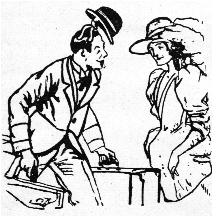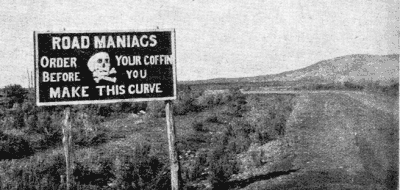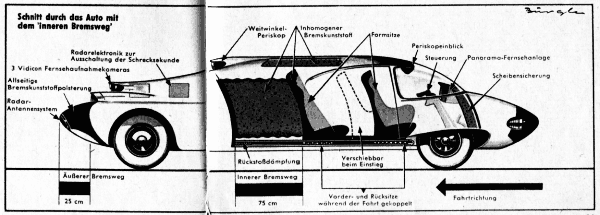
Berliner Illustrierte
Zeitung 1911
Today, this gentleman would use a mobile phone.
...but not such a long time ago. To very young people that time is far away and to very old it is strangely familiar. That time, is occasionally called "the good old time", although it was rarely good at all. That time was influenced by wars, by preceding or following "Nöten" and by unemployment. If not here, then elsewhere. In the good old time there lived also inventors. Good inventors and less good inventors. And of course they made good inventions and less good inventions, and sometimes they had very strange, progressive ideas. And some of these inventions were so good, so new and progressive that they got forgotten almost immediately. And then it took a little while until the good old time became worse, and after one or two wars, there were inventors again. Good inventors and less good inventors. And again they had many ideas, often without knowing that there were others who had the same ideas many years before. And sometimes an inventor was amongst them who knew about those old concepts and said to himself: "Ay, nowadays nobody knows that anymore; I can invent this anew". This page shows some of these new ideas which are pretty old.
 Berliner Illustrierte Zeitung 1911 |
Let's have a closer look at this gentleman who seems to look a little
bit confused. Today, he probably would wear a business suit. At his time,
a cylinder hat was appropriate. The partly opened jacket does neither indicate
a salesman of postcards, nor does the gentleman demonstrate the newest explosives
invented by russian anarchists. Instead, it is a battery package to power
the latest invention: a telectroscope. This is a wireless telegraph
receiver which is distributed over jacket, cylinder and waist belt. With
this, the gentleman can receive the latest news - stock reports supposedly.
Is the confusion caused by a drop of the exchange rates? Or simply by flattened
batteries?
Today, this gentleman would use a mobile phone. |
| In the good old time, gentlemen used to wear hats. At hat should be lifted
when you pass a person you know. Well, it has to be lifted, especially
when you meet a lady. This is demanded by courtesy. Sometimes, gentlemen
are in a hurry for their train and moreover, they carry heavy luggage. Saying
"good morning" urges to set down the luggage, which indicates that the gentleman
is prepared for a longer chat. Although he desperately might shorten the
chat, the train is gone and the good humour as well. A gentleman who had
this mishap, invented a "hat lifting apparatus" which allows to greet while
hurring along the road. The ingenious device was patented in the US in 1896.
|
 |
 |
If an electric motor is expensive and income is low, creative minds will find a way to construct a more universal machine around that motor. In 1929, this practical vacuum cleaner was invented which allows hoovering and drying hair. A machine in beautiful design - and universal as well. But why does it need two wall sockets? |
| Today, electronically controlled headlamps which allow a glance into
the curves are sold as new invention. We remember... Once upon the time there
was a car which was far ahead of its time: the DS. Passionate owners of this
(today's vintage) car say "the Déesse" and those who talk French will
know that these persons praise their car. The technology contained two headlamps
which lighed the curves. Connoisseurs have known that already.
But the idea originates in an earlier period. This sidelamp, invented 1930 fulfils the same purpose. Unfortunately the magazine "Wissen und Fortschritt" does not report how the lamp was mechanically fixed and how it had to be wired. |
 "Moveable headlamp at the front axle, turns itself into direction of driving. Every curve will be lighted" |
 |
Speeding on highways always was an issue for officals. As the victory of the automobile could no more be prevented, very early in the US suitable road signs were erected close to the highways. |
| Tire pressure control is an old issue. Electronic systems can be used for this, but it is easier to observe the correct pressure when filling the tire. This valve, invented in the 1920ies, whistles when the needed pressure is reached. Simple, cheap and reliable. Of course this invention had no success. |  |
 |
| 1960, the German popular technology magazine "hobby" presented this
sophisticated design invented by Professor Manfred von Ardenne. An automobile
which contains an internal "hay pile" made of plastic material to prevent
injuries in case of an accident even at high speed. Driver and passenger
sit reverse to the driving direction and observe the road by periscope and
monitors.
I wonder, what a large panorama window is good for? To look into the blinding headlamps of the following vehicle? And also the question how a 7-meter vehicle can be maneuvered through average narrow and curved German city streets remains unanswered. But the vehicle provides everthing that causes faster heart beat among us high-tech fanatics: radar-based distance control system to reduce the driver's reaction time, wide angle periscopes, 3 cameras to observe the traffic and an automatic shield that in case of an accident is lifted inside the wind screen in order to protect the passengers from sharp glass parts. |
| Last update: 22 December 2003 / |
|